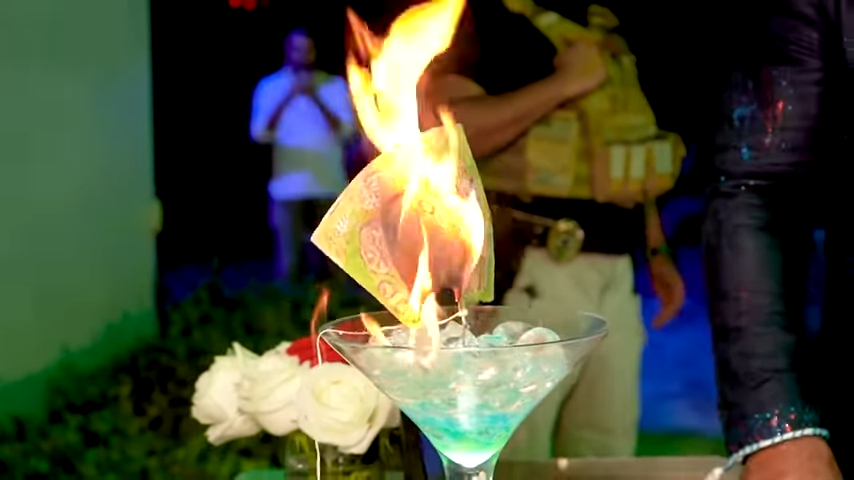'This man should be put in jail'—NFT bro burns $10 million Frida Kahlo painting as mariachi band plays
"I had to do something drastic to get attention."

A businessman is under investigation and facing possible charges after burning a sketch by the artist Frida Kahlo to promote the sale of NFTs based on it. Martin Mobarak burned the 1944 drawing, valued at $10 million, at a Miami party in a martini glass.
The Kahlo sketch was called 'Fantasmones Siniestros', or 'Sinister Ghosts', dated from 1944, and was a crayon, pencil and ink drawing showing a surreal conglomeration of creatures. It was apparently destroyed at the launch party for Frida.NFT, which aims to sell 10,000 NFTs off the back of the stunt. The New York Times reports that the project has so far sold four NFTs.
A video from the event shows Mobarak, surrounded by ludicrous levels of security, removing the picture from its frame before placing it in a martini glass and setting it alight. Almost unbelievably, a mariachi band begins playing the popular Mexican song 'Cielito Lindo'. Some in the crowd cheer the act.
"I had to do something drastic to get attention," Mobarak told The New York Times.
There is some scepticism about whether even the web 3.0 crowd would actually pull off such a crass stunt, and whether the drawing shown being burned was genuine.
Mobarak says he bought the drawing in 2015, and insists that the work he burned was authentic. The NFT site includes a certificate of authenticity and provenance for this being the original. Of those who doubt Mobarak really burned it, he says, "How do they know I didn’t?"
The Mexican National Institute of Fine Arts and Literature is now investigating whether Mobarak did burn an original Kahlo and thus committed a federal crime. Kahlo's work has been protected under Mexican law since 1984 as "artistic monuments", and the punishment could be decades in prison plus a fine equivalent to the work's value.
The biggest gaming news, reviews and hardware deals
Keep up to date with the most important stories and the best deals, as picked by the PC Gamer team.
The Frida Kahlo Museum in Coyoacan also put out a statement condemning the act, and pointed out it owned the rights to all of Kahlo's works, and had not given any permissions for an NFT being made. It called the stunt the "destruction of the cultural heritage of our country" and said it had no ties to "the collector and his activities".
Gregorio Luke, an expert on Mexican and Latin American art and culture, said: "I think this man should be put in jail".
The Frida.NFT project tries to angle this act as one of global benevolence. "This profound act was done for unfortunate and sick children, battered women and other less fortunate around the world to receive hope".
Mobarak's plan was to sell 10,000 NFTs for 3 ETH each, around $3,600 at its current price, so raising some $36 million in theory. “I’m a fan of Frida. She endured a tremendous amount of physical, mental and spiritual pain,” Mobarak told the Miami Herald. "I’m using that one small painting to create something really good that she would be happy about."
Of all the NFT trends, this idea of destroying real items in order to confer some mystical legitimacy on a digital token is among the worst. The artist Damien Hirst recently jumped on this idea, so pervasive has it become, with a 2021 project called Heni featuring 10,000 artworks where buyers had a year to choose whether to keep the original or have it destroyed and get an NFT of it. 4,581 buyers chose the NFT option. Number 17 in the collection is titled "none of this matters".
There was also a stunt in 2021 where the group 'Burnt Banksy' burned a Banksy painting. There was at least an element of wit to this example, with the Banksy piece titled Morons and depicting an auction room of people buying art at Christies.
Where this will end up is anyone's guess. Mobarak has either punked the art world, or has genuinely destroyed a work by one of the 20th century's greatest artists in order to sell NFTs that, seemingly, no one wants. Given the profile the stunt has attained it seems almost certain that, should he have burned the real thing, the Mexican authorities will look to pursue him for it, while the Kahlo Museum has a long history of seeking legal redress against misuse of her work.
"People may see it as I destroyed it," said Mobarak. "But I didn’t. This way I am bringing it to the world. I am letting everybody see it. I think it does more good for the world and makes a statement rather than just sitting in someone’s private collection."

Rich is a games journalist with 15 years' experience, beginning his career on Edge magazine before working for a wide range of outlets, including Ars Technica, Eurogamer, GamesRadar+, Gamespot, the Guardian, IGN, the New Statesman, Polygon, and Vice. He was the editor of Kotaku UK, the UK arm of Kotaku, for three years before joining PC Gamer. He is the author of a Brief History of Video Games, a full history of the medium, which the Midwest Book Review described as "[a] must-read for serious minded game historians and curious video game connoisseurs alike."

